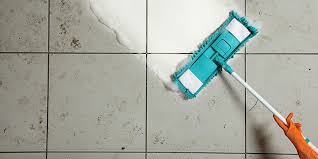Keeping tiles clean is an essential part of home maintenance. Whether it’s the tiles in your bathroom, kitchen, or living space, maintaining their shine and preventing dirt buildup requires the right approach. While regular cleaning can help, using the right tools makes all the difference. From scrubbing grime off grout lines to ensuring a streak-free shine, having a well-equipped cleaning kit ensures your tiles look their best. Discover the best methods for tile cleaning and stain removal—read this post here.

Choosing the Right Cleaning Solution
One of the first steps in effective tile cleaning is selecting an appropriate cleaning solution. Many homeowners use a mix of water and vinegar, but certain tiles, such as natural stone, require specialized cleaners to prevent damage. Store-bought solutions formulated specifically for tile surfaces offer deep cleaning power without harming the finish. It’s also important to consider whether you need a disinfectant for areas like the kitchen or bathroom, where bacteria and mold can thrive.
The Role of a Good Mop
A quality mop is crucial for keeping tiles spotless. Traditional string mops can spread dirt rather than remove it, making microfiber mops a superior alternative. These are designed to pick up dust and grime efficiently while being gentle on surfaces. Steam mops are another excellent option, as they use hot steam to break down stubborn stains and sanitize floors without the need for chemicals. This is especially useful for households with children and pets, where minimizing harsh cleaning agents is a priority.
Scrubbing Brushes for Tough Stains
While mopping works well for general maintenance, scrubbing brushes are necessary for dealing with tough stains and grime. Grout lines, in particular, can become discolored over time and require a firmer approach. A stiff-bristled brush is ideal for deep cleaning, as it can reach into crevices without damaging the surrounding tiles. Some homeowners opt for electric scrubbers, which provide extra cleaning power and reduce the effort required to scrub manually.
Grout Cleaners and Sealers
Dirty grout can make even the cleanest tiles look dull and aged. Using a specialized grout cleaner helps lift dirt and brighten the lines between tiles. For long-term protection, applying a grout sealer prevents moisture from seeping in, reducing the risk of mold and mildew. This is particularly beneficial in high-humidity areas like bathrooms, where grout is prone to discoloration.
Squeegees for Shower Tiles
Bathroom tiles, especially in the shower area, often develop water stains and soap scum. A simple yet effective tool for maintaining these surfaces is a squeegee. By running it over wet tiles after each shower, homeowners can prevent water spots and buildup, reducing the need for frequent deep cleaning. This small habit can significantly extend the life of tile surfaces and keep them looking fresh.
Vacuuming Before Mopping
Before wet cleaning, removing loose debris is essential. A vacuum with a hard floor setting or a dry dust mop works well to collect dust, dirt, and pet hair. This prevents grime from being pushed around when mopping, leading to a more thorough clean. Handheld vacuums with attachments can also be useful for reaching tight spaces and corners.
Natural vs. Chemical Cleaners
Many homeowners debate whether to use natural or chemical-based cleaning products. While natural solutions like baking soda and vinegar work well for mild stains, chemical cleaners are often necessary for tackling tougher grime. It’s best to check the manufacturer’s recommendations for your specific tile type to ensure compatibility. For those preferring eco-friendly options, enzyme-based cleaners can effectively break down dirt without harmful chemicals.
Proper Drying Techniques
After cleaning, allowing tiles to dry properly helps prevent streaks and water spots. Using a microfiber cloth or a dry mop can speed up the drying process and leave a polished finish. Good ventilation also plays a role in preventing moisture buildup, especially in bathrooms.
